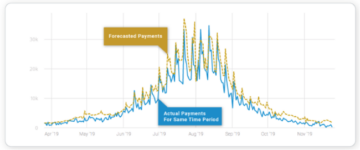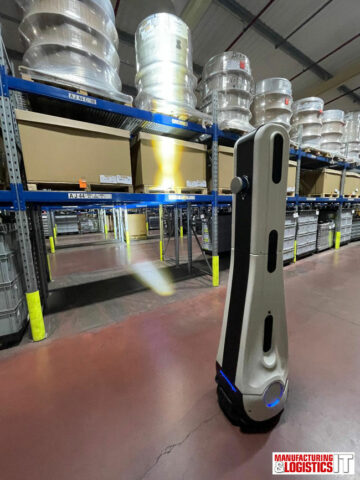By Nidhi Gupta, CEO of Portcast.
The manufacturing industry is undergoing a profound transformation in the wake of the post-pandemic era. With volumes stabilising, profit margins narrowing, and rivals multiplying, setting themselves apart in all aspects of business has become paramount for manufacturing companies.
In this quest, the timely delivery of products has emerged as a crucial factor for enhancing customer responsiveness, fulfilling commitments, and fostering lasting customer relationships. This has altered the operational dynamics of manufacturing logistics.
Logistics Has Stepped Into the Arena of Delivering Distinctive Experiences
According to Forbes, companies excelling in customer experience outperform their competitors by a staggering 80%, while 84% of businesses focusing on customer experience report increased revenues. To gain a competitive edge, large-scale manufacturers, SMEs, and freight forwarders are increasingly turning to AI-powered tools to deliver an exceptional logistics experience for their customers.
With a strong focus on exception management, companies are actively applying predictive analytics to proactively identify and address risks, resulting in minimised disruptions in their supply chains. Consequently, this approach delivers a seamless logistics experience to their end customers and optimises time and cost factors, contributing to sustainable profitability.
In this article, we delve into the profound impact of predictive analytics on manufacturing logistics, emphasising its significance as a transformative tool for manufacturing companies.

Why the Use of Predictive Analytics Is Growing in Manufacturing Logistics
In manufacturing companies, the material flow is a cornerstone of efficient production and logistics. Effectively manoeuvring goods through the entire manufacturing process can circumvent bottlenecks, enhance production planning, and trim costs—an objective that is achieved through the intricate web of the supply chain.
Yet, the supply chain is fraught with risks as it involves the interconnectedness of suppliers, manufacturers, and end customers. Within this complex web, a single disturbance has the potential to trigger a domino effect that resonates throughout the entire supply chain. In today’s business environment, where customers exhibit minimal tolerance for missed or tardy deliveries, these interruptions can result in customer loss and, ultimately, impact the bottom line.
Longer transit times filled with bottlenecks, weather fluctuations, and numerous other possible disruptions in ocean transportation have necessitated the application of visibility technology with predictive analytics. What’s remarkable about this revolutionary technology is its growing affordability and accessibility, making it attainable for small and medium-sized manufacturing enterprises, thereby facilitating its widespread adoption.
As more and more businesses embrace advanced data analytics, the predictive analytics market is poised for substantial growth, projected to reach $38 billion by 2028, up from $12.49 billion in 2022. This information underscores the growing acknowledgement among businesses regarding the significance of the technology.
The Transformative Power of Predictive Analytics in Manufacturing Logistics
Imagine you’re a logistics manager for a company that exports electronic components to overseas clients via ocean transportation. One day, you receive an urgent call from a customer experiencing delays in their production line due to a late shipment from your end. The following scenarios may unfold based on the level of visibility in your transportation logistics:

Comparison between reactive, real-time, and predictive visibility approaches
Preventing Logistics Hiccups with the Aid of Predictive Analytics: Examples
Exception management plays a pivotal role in ensuring the smooth operation of ocean transportation logistics. Any deviation from the anticipated outcome can be categorised as an “exception,” these exceptions can potentially disrupt cargo movement, lead to delivery delays, and impact overall supply chain efficiency.
By leveraging historical data and advanced analytics, manufacturing logistics can proactively manage these exceptions or risks. Key considerations include:
Shipping Routes Optimisation
Real-time data on port congestion and weather forecasts are harnessed by predictive analytics to suggest the shortest and least congested routes, saving time and reducing emissions.
For instance, in the food and beverage manufacturing sector, where product freshness is crucial, predictive analytics helps optimise fleet performance by analysing data on shipping routes, weather patterns, and congestion, ensuring timely and fresh deliveries.
Predictive Delay Notifications
Utilising predictive analytics, companies can proactively identify containers at risk, drawing attention to potential delays caused by factors such as port congestion, weather conditions, vessel rotation adjustments, and container rollovers.
Let’s explore an example to illustrate a potential rollover scenario at a transhipment port. Imagine Vessel 1, carrying your containers, is running behind schedule and is expected to arrive at the transhipment port later than the scheduled departure of Vessel 2, which is responsible for loading and transporting your cargo to the destination port. This situation represents a rollover scenario, which, if managed reactively, might only become apparent after the fact.
However, with the power of predictive analytics, you gain a proactive edge. This real-time predictive analysis is designed to promptly detect and alert in case of such risks, thereby minimising disruptions and delays in your supply chain and ensuring smoother and more reliable logistics operations.

Illustration of a typical rollover case when Vessel #1 is arriving transhipment port after the departure of Vessel #2 which was assigned to carry a container to POD
Predictive analytics enables proactive responses when essential inventory is depleting, or safety stock is dwindling. To illustrate this point, let’s revisit the scenario of a potential rollover occurring at a transhipment port, where containers carrying vital stock are in transit. Anticipating this risk beforehand empowers stakeholders to take strategic measures, such as altering the transportation mode from sea to air at the transhipment point or adjusting the vessel choice.
Let’s explore another scenario: envision a labour strike unfolding at the transhipment port, poised to extend the dwell time and potentially disrupt delivery timelines. Being aware of this risk in advance enables strategic cargo planning, including the option of rerouting to an alternative transhipment port. This proactive approach can also be applied to contingencies such as the recent Panama Canal drought, where prior knowledge of these potential disruptions allows for cost-effective shipment rerouting well ahead of schedule.
Importantly, recommendations for these actions can be tailored based on the criticality of the shipment, ensuring that resources are allocated most efficiently to safeguard critical deliveries.
Carrier Reliability
Evaluating the performance of shipping lines for specific trade lanes or geographies to see if the selected carriers consistently meet the expected Estimated Time of Departure (ETD) and Estimated Time of Arrival (ETA). Predictive analytics can identify carriers that exhibit varying degrees of deviation from planned schedules, helping companies make informed decisions about carrier selection.

Graph depicting transit time comparison between two carriers for the China-USA route (Source: Data from Portcast’s Transit Time dashboard)
The graph above provides a granular level of insights, offering data on transit times between various geographies and specific Port of Loading (POL) and Port of Destination (POD) pairs. Moreover, these insights are presented on a week-over-week basis, enhancing the depth and comprehensiveness of the data. These parameters give you an overview of each carrier’s on-time arrival percentage on specific trade routes. This facilitates the selection of the most reliable carriers for your frequently used trade routes.

An illustration of carrier reliability between two port pairs presented as a chart
Based on the data above, logistics teams can make an informed decision in choosing the most reliable carrier (Carrier B, in this case) for a particular trade route.
Benefits of Predictive Analytics in Manufacturing Logistics
Gartner reports that companies embracing predictive supply chain solutions are reaping the highest returns on their investments. Transportation expenses, constituting a substantial portion of the final product’s price tag, are a prime target for optimisation through predictive analytics.
The advantages of applying predictive analytics in transportation logistics extend to both daily operational tasks and the strategic foresight needed to attain growth and revenue objectives. Let’s explore some of these benefits:
1. Proactive Planning with Predictive ETAs
Predictive analytics takes centre stage in the form of Estimated Time of Arrival (ETA) forecasting. Acquiring an ETA for a shipment in transit carries a multitude of advantages for logistics in manufacturing. Sharing these ETAs with end customers gives them crucial visibility into their shipments, empowering shippers to manage expectations and ensure on-time deliveries.
2. Enhanced Supply Chain Visibility
Predictive analytics enhances the functionality of a supply chain visibility solution by furnishing a comprehensive view of shipment status and location, coupled with contextual intelligence on potential disruptions. This proactive approach helps avoid expenses linked to delayed or off-schedule shipments while simultaneously strengthening customer relationships. Consequently, meeting visibility requirements not only fosters customer loyalty but also opens the door to fresh business prospects.
For instance, in the food and beverage manufacturing sector, where product freshness is crucial, predictive analytics helps optimise fleet performance by analysing data on shipping routes, weather patterns, and congestion, ensuring timely and fresh deliveries.
3. Better Supplier Management
Predictive analytics proves invaluable in identifying optimal suppliers based on cost-effectiveness, delivery reliability, sustainable practices, and more. By spotting best practices and improvement opportunities, businesses can effectively manage supplier relationships, steer clear of pitfalls, negotiate favourable terms, and bolster profits.
4. Emphasis on Sustainability
Amidst growing environmental awareness, manufacturers face increasing pressure to embrace sustainability throughout their operations, extending from raw material sourcing to end-product transportation.
In the domain of transportation, predictive analytics offers invaluable support by pinpointing areas where fuel consumption and emissions can be curtailed, all the while streamlining operations to align with environmental sustainability. Predictive analytics is poised to play a pivotal role in forthcoming sustainability initiatives, including reducing carbon footprints and harmonising manufacturing practices with eco-conscious principles.
Key Advantages: Summarised
- Avoiding inventory shortages by forecasting potential disruptions accurately. This prevents costly shortages and ensures products are readily available when customers need them.
- Minimising delays as predictive analytics acts as a shield against unforeseen disruptions in the supply chain. It allows organisations to take pre-emptive measures to keep operations running smoothly, reducing the risk of costly delays.
- Reducing operational costs and time by optimising transportation routes and choosing reliable carriers. This significantly reduces operational costs and the time it takes to fulfil orders.
- Improving customer relationships by offering them accurate delivery ETAs, which fosters customer loyalty and satisfaction.
Final Thoughts
Every business’s supply chain is a treasure trove of data waiting to be leveraged for transformative results. The fusion of supply chain visibility software with predictive analytics has the potential to create an outsized positive impact on your Return on Investment (ROI). It’s not merely a tool; it’s a compass guiding businesses toward a future where logistics success becomes not just a necessity but a strategic advantage—a future where efficiency, customer satisfaction, and sustainability reign supreme.
- SEO Powered Content & PR Distribution. Get Amplified Today.
- PlatoData.Network Vertical Generative Ai. Empower Yourself. Access Here.
- PlatoAiStream. Web3 Intelligence. Knowledge Amplified. Access Here.
- PlatoESG. Carbon, CleanTech, Energy, Environment, Solar, Waste Management. Access Here.
- PlatoHealth. Biotech and Clinical Trials Intelligence. Access Here.
- Source: https://www.logisticsit.com/articles/2023/10/19/how-predictive-analytics-has-been-impacting-manufacturing-logistics
- :has
- :is
- :not
- :where
- $UP
- 1
- 2022
- 2028
- 385
- 49
- a
- About
- above
- accessibility
- accurate
- accurately
- achieved
- acquiring
- actions
- actively
- acts
- address
- adjusting
- adjustments
- Adoption
- advance
- advanced
- advantages
- After
- against
- ahead
- AI-powered
- Aid
- AIR
- Alert
- align
- All
- allocated
- allows
- also
- altered
- alternative
- among
- an
- analysis
- analytics
- and
- Another
- Anticipated
- anticipating
- any
- apart
- apparent
- Application
- applied
- Applying
- approach
- ARE
- areas
- Arena
- arrival
- arriving
- article
- AS
- aspects
- assigned
- At
- attain
- Attainable
- attention
- available
- avoid
- aware
- awareness
- b
- based
- basis
- BE
- become
- becomes
- been
- behind
- being
- benefits
- BEST
- best practices
- Better
- between
- BEVERAGE
- Billion
- bolster
- both
- bottlenecks
- Bottom
- business
- businesses
- but
- by
- call
- CAN
- carbon
- Cargo
- carriers
- carry
- carrying
- case
- categorised
- caused
- centre
- ceo
- chain
- chains
- choice
- choosing
- circumvent
- clear
- clients
- commitments
- Companies
- company
- comparison
- Compass
- competitive
- competitors
- complex
- components
- comprehensive
- conditions
- congestion
- Consequently
- considerations
- consistently
- consumption
- Container
- Containers
- contextual
- contributing
- cornerstone
- Cost
- cost-effective
- costly
- Costs
- coupled
- create
- critical
- criticality
- crucial
- customer
- customer experience
- Customer Loyalty
- Customer satisfaction
- Customers
- daily
- dashboard
- data
- Data Analytics
- day
- decision
- decisions
- delay
- Delayed
- delays
- deliver
- Deliveries
- delivering
- delivers
- delivery
- delve
- depicting
- depleting
- depth
- designed
- destination
- detect
- deviation
- Disrupt
- disruptions
- distinctive
- domain
- domino
- Door
- drawing
- Drought
- due
- dynamics
- each
- Eco-conscious
- Edge
- effect
- effectively
- efficiency
- efficient
- efficiently
- Electronic
- embrace
- embracing
- emerged
- Emissions
- emphasis
- empowering
- empowers
- enables
- end
- enhance
- enhanced
- Enhances
- enhancing
- ensure
- ensures
- ensuring
- enterprises
- Entire
- Environment
- environmental
- Environmental Sustainability
- envision
- Era
- essential
- estimated
- Ether (ETH)
- example
- exception
- exceptional
- exhibit
- expectations
- expected
- expenses
- experience
- experiencing
- explore
- exports
- extend
- extending
- Face
- facilitates
- facilitating
- fact
- factor
- factors
- filled
- final
- FLEET
- flow
- fluctuations
- Focus
- focusing
- following
- food
- For
- Forbes
- forecasts
- foresight
- form
- forthcoming
- fostering
- fosters
- freight
- frequently
- fresh
- from
- Fuel
- fulfilling
- functionality
- fusion
- future
- Gain
- geographies
- Give
- gives
- goods
- graph
- Growing
- Growth
- Gupta
- Have
- helping
- helps
- highest
- historical
- How
- HTTPS
- identify
- identifying
- if
- illustrate
- imagine
- Impact
- impacting
- improvement
- in
- include
- Including
- increased
- increasing
- increasingly
- industry
- information
- informed
- initiatives
- insights
- instance
- Intelligence
- into
- intricate
- invaluable
- inventory
- investment
- Investments
- involves
- IT
- ITS
- jpg
- just
- Keep
- Key
- knowledge
- Labour
- large-scale
- lasting
- Late
- later
- lead
- least
- let
- Level
- leveraged
- leveraging
- Line
- lines
- linked
- loading
- location
- logistics
- loss
- Loyalty
- make
- Making
- manage
- managed
- management
- manager
- Manufacturers
- manufacturing
- manufacturing industry
- Manufacturing sector
- margins
- Market
- material
- May..
- measures
- Meet
- meeting
- merely
- might
- minimal
- missed
- Mode
- more
- Moreover
- most
- movement
- multiplying
- multitude
- necessity
- Need
- needed
- numerous
- objective
- objectives
- occurring
- ocean
- of
- offering
- Offers
- on
- ONE
- only
- opens
- operation
- operational
- Operations
- opportunities
- optimal
- optimise
- Option
- or
- orders
- Organisations
- Other
- Outcome
- Outperform
- overall
- overseas
- overview
- pairs
- Panama
- parameters
- Paramount
- particular
- patterns
- percentage
- performance
- pivotal
- planned
- planning
- plato
- Plato Data Intelligence
- PlatoData
- Play
- plays
- Point
- poised
- positive
- possible
- post-pandemic
- potential
- potentially
- power
- practices
- predictive
- Predictive Analysis
- Predictive Analytics
- presented
- pressure
- prevents
- price
- Prime
- principles
- Prior
- Proactive
- process
- Product
- Production
- Products
- Profit
- profitability
- profits
- profound
- projected
- prospects
- proves
- provides
- quest
- Raw
- RE
- reach
- readily
- real-time
- reaping
- receive
- recent
- recommendations
- reduces
- reducing
- reducing emissions
- regarding
- Relationships
- reliability
- reliable
- remarkable
- report
- Reports
- represents
- Requirements
- resonates
- Resources
- responses
- responsible
- result
- resulting
- Results
- return
- returns
- revenue
- revenues
- revolutionary
- Risk
- risks
- rivals
- ROI
- Role
- rollover
- Route
- routes
- running
- s
- Safety
- satisfaction
- saving
- scenario
- scenarios
- schedule
- scheduled
- SEA
- seamless
- sector
- see
- selected
- selection
- setting
- sharing
- Shield
- Shipping
- shortages
- significance
- significantly
- simultaneously
- single
- situation
- small
- SMEs
- smooth
- smoother
- smoothly
- solution
- Solutions
- some
- Source
- Sourcing
- specific
- spotting
- Stage
- staggering
- stakeholders
- Status
- steer
- stock
- Strategic
- streamlining
- strengthening
- strike
- strong
- substantial
- success
- such
- suggest
- supplier
- suppliers
- supply
- supply chain
- Supply Chain Visibility
- Supply chains
- support
- Supreme
- Sustainability
- sustainable
- TAG
- tailored
- Take
- takes
- Target
- tasks
- teams
- Technology
- terms
- than
- that
- The
- their
- Them
- themselves
- thereby
- These
- this
- Through
- throughout
- time
- timelines
- timely
- times
- to
- today
- tolerance
- tool
- tools
- toward
- trade
- Transformation
- transformative
- transit
- transportation
- transporting
- trigger
- Turning
- two
- typical
- Ultimately
- undergoing
- underscores
- unfolding
- unforeseen
- urgent
- use
- used
- various
- varying
- Vessel
- via
- View
- visibility
- vital
- volumes
- Waiting
- Wake
- was
- we
- Weather
- weather patterns
- web
- WELL
- What
- when
- which
- while
- widespread
- with
- within
- you
- Your
- zephyrnet












